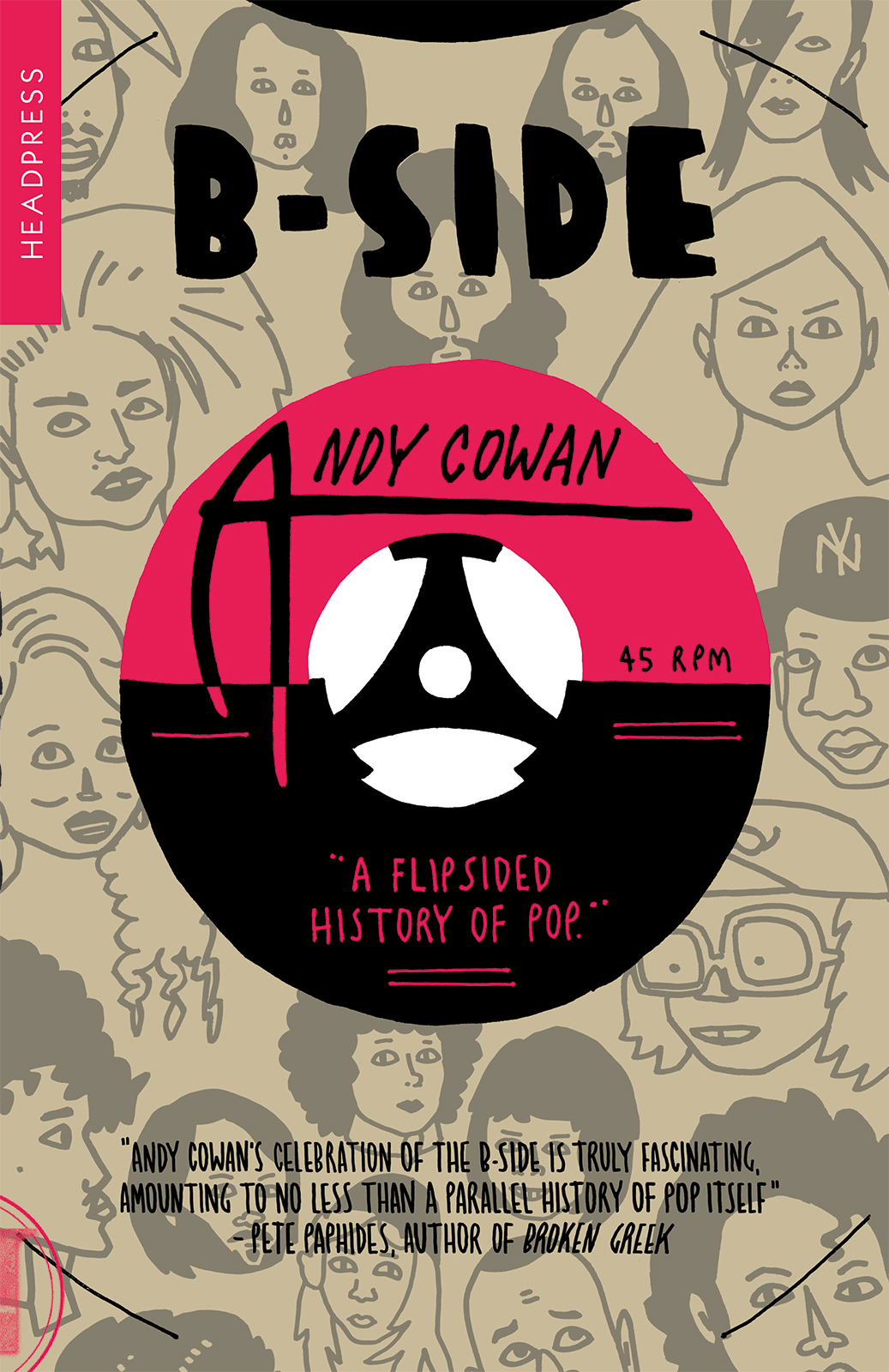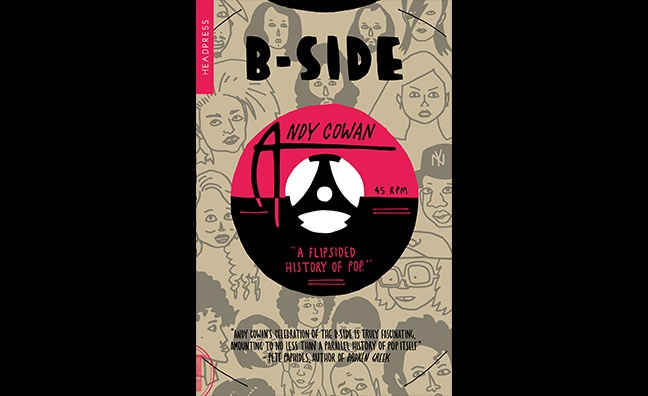Today (July 6), marks the publication of B-Side: A Flipsided History Of Pop – a brand new history of the evolution of the B-Side by Andy Cowan.
Published by Headpress and billed as “the first serious examination of the format’s covert role in pushing the musical envelope”, it tackles over 500 B-Sides from the likes of everyone from the Beatles, Kinks and Yardbirds to Prince, Oasis, The Cure, 2Pac, Bill Haley, Donna Summer, Queen, Pulp and Radiohead.
Here Music Week speaks to its author Andy Cowan – a writer for Mojo and the former editor of the much-missed Hip-Hop Connection – to find out more about life on the flip-side of pop history…
The most obvious place to start is why you felt inspired to write the book?
“In many ways B-Side came about by accident. I’ve been collecting records since I was 11 and, during lockdown, decided to catalogue my collection. What should have been fairly straightforward turned into a small marathon, as I started listening back to loads of old singles. I quickly realised that many of my favourite songs weren’t necessarily the A-Sides. That’s particularly true for records bought in my teens, where every penny counted and every song received multiple plays. I was idly thinking about one of those B-Sides – not a particularly well known one, Stephen by Gene Loves Jezebel – when I wondered if anyone had written in depth about B-Sides. I felt sure they must have, but no. So that was the catalyst. It’s a book that I really wanted to read.”
It’s billed by the publisher as “the first serious examination of the format’s covert role in pushing the musical envelope” – why has the B-Side as a phenomenon escaped the attention it deserves?
“B-Sides have been written about a lot, but only in dispatches. There’s lot of '10 Great B-side' posts online, for example, but they feel like footnotes or easy clickbait. I don’t think anyone was foolhardy enough to take it on as a whole – it’s so vast. A strange quirk of formatting that dates back to 1910, the B-Side is unique unto pop and the way it is parcelled. Notionally considered the lesser track – a notion that the book works hard to disprove – it would seem crazy to ask a novelist or artist to knock out an inferior book or painting just so that they could sell their masterpiece. Yet that’s exactly what the B-Side demanded of its creators.”
On that aforementioned idea of its "covert role" – what are some of the most interesting examples of artists who really used B-sides to experiment musically in a way that perhaps they weren’t at liberty to – due to commercial or label pressures – on their albums?
“I absolutely love Billie’s Blues, a song Billie Holiday improvised on the spot, with a great sinister undertow. The Beatles’ Rain is important. First recorded during the sessions for Revolver, they tidied it up for the B-Side of Paperback Writer with producer George Martin manipulating the speed to texturally change its whole sonic palette. It proved a major turning point in their approach to studio work. A personal favourite is the clunkily titled 1. David Jay 2. Pete Murphy 3. Kevin Haskins 4. Daniel Ash, which was Bauhaus using the surrealist’s exquisite corpse approach – an audio form of Consequences – with each member recording their part in isolation.
In terms of commercial pressures, I’m continually fascinated by '70s glam rockers the Sweet. Apart from singer Brian Connelly, they didn’t even feature on their A-sides, which were written by managers Nicky Chinn and Mike Chapman and played by session musicians. They did control their B-sides though, penning great metal anthems like Man From Mecca, Restless and Medusa. That was important because a single’s publishing royalties had a financial incentive – split 50:50 regardless of A or B.”

From a purely practical level, how did you go about researching this and choosing which ones to zero in on? The task must have been quite daunting to say the least...
“It started simply, with a spreadsheet list of all the notable B-Sides I could think of. It mushroomed rapidly. I wanted it to have a populist spine, so I initially honed in on the B-Sides of the 100 best-selling artists. I had numerous potential inclusions at this point, so decided to restrict it to one B-Side apiece, just to narrow the field. After that I really broadened the search, exhaustively trawling by decade and by genre etc. Outside music journalism I work in academia, often on systematic reviews, so I applied some scientific search strategies and academic rigour to the quest. It ultimately entailed listening to thousands and thousands of B-Sides and trying to rank them in order of importance. And while fan forums proved helpful, it was rabbit hole that ate up weeks rather than days. The end result was 501 significant B-Sides, which run in an A-Z format. Other B-Side trends also emerged during the research – such as B-Sides about B-Sides, Part 2’s, dub versions – so I captured a further 160-odd B-sides in its interweaving chapters. Because I wanted it work as a loose reference book, many of my own personal favourite B-Sides didn’t make the cut, although I’m covering some now in blog form at b-side.website.”
Taking a broad historical view, is there a decade you think produced the greatest number of culturally significant B-sides?
“I would say there’s four consecutive decades that constitute its golden age, each very different. Rock ’n’ roll finally achieved lift off in the 50s when Bill Haley & His Comets B-side (We’re Gonna) Rock Around The Clock was included in the opening credits of Blackboard Jungle. Great B-sides came thick and the fast afterwards, be it Gene Vincent’s Be-Bop-A-Lula, Vince Taylor’s Brand New Cadillac or Elvis Presley’s Hound Dog. The '60s was a golden period for soul and R&B with labels like Motown and Stax churning out brilliant double-sided singles orchestrated by their respective house bands the Funk Brothers and the MG’s. Punk and the explosion of independent acts it inspired signalled a late 70s B-side boom. It helped that John Peel, its biggest champion on Radio 1, invariably played the B-sides too. The advent of the 12-inch single in the 80s – allowing for up to four extra tracks — proved a great expanded canvas for B-side embracers such as Depeche Mode, the Cure or the Stone Roses to really have fun with.”
B-sides are considered the lesser track – it's a notion this book works hard to disprove
Andy Cowan
I’m curious to know about the acts that really elevated the B-Side’s status in your eyes. Pearl Jam, for one, are known for playing all their tracks live but even then, their B-side Yellow Ledbetter becoming one of their signature set closers and being played live more than a lot of their radio hits is quite a remarkable elevation of the B-side...
“That’s a great example of how B-sides are a part of fandom too, when knowing a band’s lessor known sides signals the depth of your devotion. It’s impossible to not mention the Smiths, who had an embarrassment of riches on their B-sides, be it the brilliant live reading of Handsome Devil or How Soon Is Now?, possibly their most iconic song. Suede essentially copied the Smiths template – eventually releasing Sci-Fi Lullabies, a double album of B-sides – and early Oasis singles were defined by softer Noel sung B-sides like Half The World Away and Talk Tonight. Prince springs to mind too, using B-sides like Irresistible Bitch, Scarlet Pussy and Erotic City to lewdly explore themes that his A-sides couldn’t.”
One of 2Pac’s most famous songs, Hit ’Em Up, never appeared on a studio album, but rather was a B-side. What are the standout hip-hop B-sides in your mind and why? Is there anything about the way hip-hop used B-sides that distinguishes it as a genre?
“Hit ’Em Up is absolutely crazy – once heard, never forgotten, from its opening declaration of war on the Notorious BIG onwards. But while it brought their feud into vivid focus, amid simmering eat/west coast tensions, it’s desperately sad too – within three months 2Pac was dead. It stands in the grand tradition of rappers using B-sides as a forum to dis their rivals, be it LL Cool J tearing into Kool Moe Dee on Jack The Ripper, Dr Dre roping in his Death Row signings to have a pop at Eazy-E on Puffin’ On Blunts And Drankin' Tanqueray, or Black Sheep targeting MC Hammer on HAA (Here’s Another Asshole). My favourite hip-hop flip is Public Enemy’s Rebel Without A Pause though, a revolution in sound that they rushed onto a B-side just to get it out there.”
I'm interested in where you think the B-side stands in 2023? Do enough artists take them seriously? Has dropping one-off songs whenever they want on streaming made them obsolete, or are there recent examples of B-sides that really impress you?
“It hurts to say it, but I think the B-side is sadly over, a casualty of streaming culture. In many ways we’ve come full circle, back to the one-sided singles of the late 1890s. That said, for artists that still press physical formats, it’s a great forum to try something more risqué or unusual. My favourite recent B-side is Wokey Cokey by Anonymous Sources feat. Aidan Moffat – a brilliant take down of anti-woke keyboard warriors that, much like the Anti-Nowhere League’s So What?, doesn’t mince its words.”
Finally, please complete this sentence: My favourite B-side of all time…
“Has changed numerous times while writing the book. It was a lot of fun to write and a great voyage of discovery. I keep coming back to Bill Withers’ Ain’t No Sunshine – one of the greatest evocations of heartache and a beautiful song. Withers was apparently apoplectic that his label Sussex made it a B-side. Had radio DJs not decided to play the B-side over the A, he might not have had a career at all. As the book makes clear, he’s not the only one.”
You can order B-Side: A Flipsided History Of Pop here.










